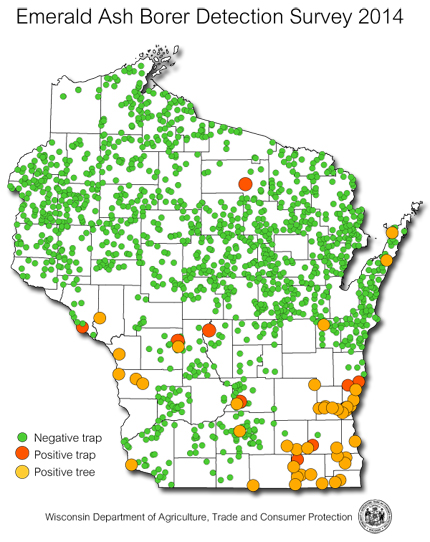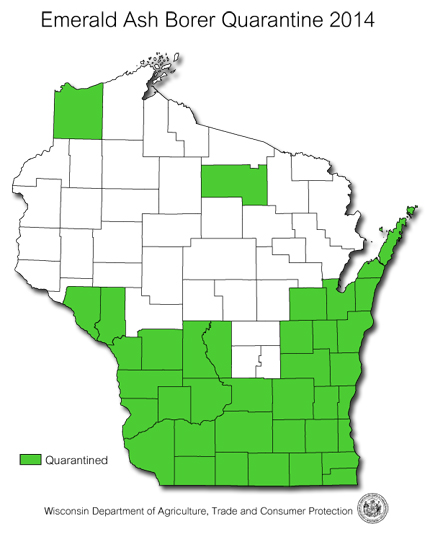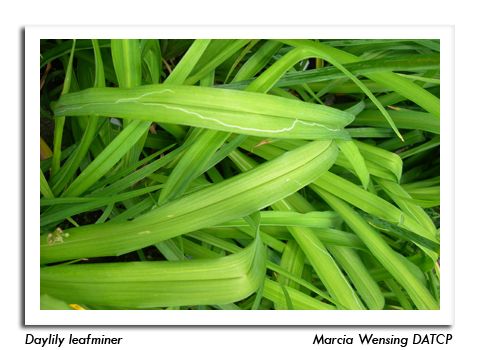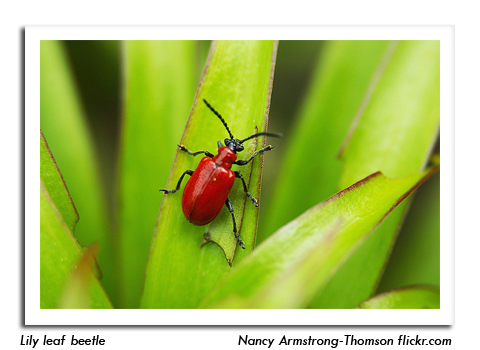
 |
|
|
Nursery & Forest
Volume 59 Number 18 Date 11/13/2014 EMERALD ASH BORER - Continued survey work for EAB resulted in 51 new detections in 2014. The beetle was captured on nine purple panel traps and infested trees were identified at 42 municipal sites. Existing infestations continued to expand and intensify this year, particularly in the southeastern and southwestern parts of the state where EAB was first discovered in 2008 and 2009, respectively. Dead trees, thinning canopies and other signs of infestation are now evident in these regions. The 2014 Wisconsin EAB trapping survey consisted of 1,301 baited purple panel traps set across 57 counties, with densities higher in the northern half of the state. Nine of the traps, one each in Adams, Buffalo, Columbia, Monroe, Oneida, Walworth and Waukesha counties and two in Sheboygan County, captured EAB adults. In response to the 51 new detections, 16 counties were added to the Wisconsin EAB quarantine: eight as the direct result of new finds, and the other half based on close proximity to an infestation. A total of 37 counties have been quarantined for EAB since 2008. WALNUT TWIG BEETLE - A trapping survey for this insect component of the thousand cankers disease (TCD) complex was conducted for the third consecutive year. The survey included 40 pheromone-baited funnel traps, two per site, set at eight municipal brush disposal sites and 12 sawmills in Buffalo, Chippewa, Crawford, Dane, Grant, La Crosse, Langlade, Manitowoc, Richland, Sauk, Shawano, Trempealeau, Vernon and Waupaca counties. The walnut twig beetle was not detected in the trap contents examined as of November 13, though sample processing is incomplete. Neither the walnut twig beetle nor the Geosmithia morbida fungal component of TCD has been found in Wisconsin to date. MOUNTAIN PINE BEETLE - Twenty-two Lindgren funnel traps were placed at 11 forest products facilities in Barron, Dunn, Juneau, La Crosse, Outagamie, Portage, Price, Shawano, Taylor and Waushara counties to detect the mountain pine beetle (MPB), the tiny bark-boring insect responsible for killing pine trees over millions of acres in the Western U.S. and Canada in the last decade. Sample screening is still under way, but results have been negative so far. -- Renee Pinski, DATCP Forest Entomologist VIRUSES IN ORNAMENTALS - Nursery inspectors collected 228 virus-symptomatic plant samples representing 80 genera from 71 producers and retailers this season. Each sample was tested for up to 12 host-appropriate viruses. Of the 228 samples, 84 (37%) were infected with at least one virus. The potyvirus group was the most frequently detected, with 19 of 51 samples testing positive (37%), followed by tobacco rattle virus in 23 of 102 samples (23%). Impatiens necrotic spot virus was diagnosed in six of 71 samples (9%), cucumber mosaic virus was found in six of 87 samples (7%), and one of 68 samples (2%) was positive for tomato spotted wilt virus. Several other viruses were also detected. Hosta virus X was found in five of 19 hosta samples (26%), dahlia common mosaic caulimovirus was identified in two of three dahlia samples (67%), and the new clematis chlorotic mottle tombusvirus was diagnosed in five of six clematis plants tested, for an 83% positive rate. A trace-forward investigation of petunias for tobacco mosaic virus resulted in 12 of 38 samples (32%) testing positive. Nursery inspectors required all virus-infected nursery stock to be removed from sale and destroyed. IMPATIENS DOWNY MILDEW - This destructive impatiens disease was intercepted in a Wisconsin greenhouse on May 29. Laboratory analysis of 15 impatiens samples collected from the site found six (40%) to be positive for impatiens downy mildew. Five additional cases of the disease, two in Milwaukee and one each in Pierce, Rock and Washington counties, were also confirmed by the UW-Madison Plant Disease Diagnostics Clinic this season. Impatiens downy mildew has been widespread in U.S. greenhouses and landscape settings in the last three years, with Wisconsin and more than 30 other states reporting cases. SUDDEN OAK DEATH - Eleven ornamental samples, seven rhododendron and four pieris, were tested this year for Phytophthora ramorum, the plant pathogen known to cause sudden oak death (SOD). The samples were "trace forwards" from a confirmed Phytophthora ramorum-infected nursery. Three of the rhododendrons and two pieris were diagnosed with Phytopthora plurivora. Another pieris plant was infected with both P. plurivora and P. citrophthora. All plants were negative for P. ramorum. PINE WILT - Two conifers exhibiting symptoms of pine wilt, one Austrian pine from St. Croix County and a Fraser fir from Marinette County, were submitted for laboratory testing. Both were negative for the pinewood nematode pathogen that causes this disease. Although no major outbreaks have occurred in Wisconsin in recent years, the incidence of pine wilt has been increasing in the Midwest since about 2000. Pine wilt is a fatal disorder that usually kills affected trees within a few weeks to a few months. Spread of the pinewood nematode from tree to tree occurs via the white-spotted pine sawyer beetle. CHRISTMAS TREE ROOT ROT - A fourth annual survey for Phytophthora root rot of Christmas trees was conducted in 2014. A total of 29 diseased conifer samples from Christmas tree fields in 12 counties were collected during September and October inspections and tested for root rot. Twenty-one percent of the samples (six of 29) from fields in Dodge, Langlade, Lincoln and Manitowoc counties tested positive for one or more distinct Phytophthora species: Phytophthora europaea, P. cactorum, P. megasperma, and P. sansomeana. The 21% incidence rate in 2014 was a negligible increase from 20% in 2013. Other diseases associated with Christmas tree decline and mortality this year were Annosum, Armillaria root rot, blue stain fungi, Cytospora canker, Phomopsis stem canker, Rhizosphaera needle cast and Sclerophoma shoot blight. Compacted roots were also a common problem again in 2014. -- Anette Phibbs, DATCP Plant Pathologist GYPSY MOTH - Moth counts decreased substantially in 2014. The annual trapping survey resulted in the capture of 92,786 male moths in 13,105 traps (seven per trap), a 63% decline from 353,134 moths in 18,513 traps (19 per trap) in 2013. As has been the trend for the past several years, the highest counts were registered in Bayfield (11,228 moths), Jackson (11,700 moths) and Monroe (9,704 moths) counties. A major increase from 994 to 4,884 moths was also documented in Trempealeau County. Program coordinators attribute the reduction in moth populations to a frigid winter and abnormally wet spring. Defoliation surveys conducted by the DNR found generally light feeding damage this year, with about 80 acres of moderate defoliation observed in Ashland County. Approximately five acres in Jefferson County were heavily defoliated. -- Rick Hummel, DATCP Gypsy Moth Program NEW NURSERY PESTS - Annual nursery inspections resulted in the detection of two new pest insects in 2014: the daylily leafminer, Ophiomyia kwansonis, and the lily leaf beetle, Lilioceris lilii. The daylily leafminer, while unconfirmed as a new state record, was found in July at nurseries in Dodge and Milwaukee counties. The lily leaf beetle was first observed in June in a Mosinee nursery and later reported from at least 17 Marathon County residences from July to September. The geographic distribution in the state and potential impact of these newly introduced species has yet to be determined. INVASIVE SPECIES RULE - Nursery inspectors continued to enforce Wisconsin's Invasive Species Rule (Chapter NR 40) this season. Rule violations involving the prohibited or restricted plants blue dune lyme grass, Japanese knotweed, parrot feather, porcelain berry, Tatarian honeysuckle and yellow floating heart were documented at 13 locations this year. -- Ellen Hermanson, DATCP Nursery Inspector 





|
|
|